The Role of Farmland Titling in Urban Agricultural Resilience: Evidence from Metropolitan Guangzhou, China
Abstract
1. Introduction
2. Literature Review
2.1. Urban Agriculture and Resilience
2.2. The Allocation of Production Factors of UFHs
2.3. Farmland Titling and the Allocation of Rural Households’ Production Factors
3. Theoretical Analysis
4. Study Area
4.1. Macro-Performance of the Allocation of Rural Production Factors in Guangzhou
4.1.1. Farmland Transfer
4.1.2. Rural Labor Allocation
4.1.3. Investment in Agricultural Production: Pesticides and Fertilizers
4.2. Implementation of Farmland Titling Policy in Guangzhou
5. Data Source and Variable Selection
5.1. Data Source
5.2. Variables
6. Empirical Analysis
6.1. Model Design
6.2. Benchmark Model
6.3. Robustness Test
6.4. Heterogeneity
7. Discussion
8. Conclusions
Author Contributions
Funding
Institutional Review Board Statement
Informed Consent Statement
Data Availability Statement
Conflicts of Interest
References
- United Nations Department of Economic and Social Affairs. 2018 Revision of World Urbanization Prospects; United Nations Department of Economic and Social Affairs: New York, NY, USA, 2018. [Google Scholar]
- Langemeyer, J.; Madrid-Lopez, C.; Beltran, A.M.; Mendez, G.V. Urban agriculture—A necessary pathway towards urban resilience and global sustainability? Landsc. Urban Plan. 2021, 210, 104055. [Google Scholar] [CrossRef]
- Orsini, F.; Kahane, R.; Nono-Womdim, R.; Gianquinto, G. Urban agriculture in the developing world: A review. Agron. Sustain. Dev. 2013, 33, 695–720. [Google Scholar]
- Norris, K. Agriculture and biodiversity conservation: Opportunity knocks. Conserv. Lett. 2008, 1, 2–11. [Google Scholar] [CrossRef]
- Brown, K.H.; Jameton, A.L. Public health implications of urban agriculture. Public Health Policy 2000, 21, 20–39. [Google Scholar] [CrossRef]
- Inwood, S. Agriculture, health insurance, human capital and economic development at the rural-urban-interface. J. Rural Stud. 2017, 54, 1–14. [Google Scholar] [CrossRef]
- Elmqvist, T.; Andersson, E.; Frantzeskaki, N.; McPhearson, T.; Olsson, P.; Gaffney, O.; Takeuchi, K.; Folke, C. Sustainability and resilience for transformation in the urban century. Nat. Sustain. 2019, 2, 267–273. [Google Scholar] [CrossRef]
- Redwood, M. Agriculture in Urban Planning—Generating Livelihoods and Food Security; Earthscan: London, UK, 2009. [Google Scholar]
- Mendes, W.; Balmer, K.; Kaethler, T.; Rhoads, A. Using land inventories to plan for urban agriculture experiences from Portland and Vancouver. J. Am. Plan. Assoc. 2008, 74, 435–449. [Google Scholar] [CrossRef]
- Bakker, N.; Dubbeling, M.; Guendel, S.; Sabel-Koschella, U.; Zeeuw, H.D. Growing Cities, Growing Food: Urban Agriculture on the Policy Agenda. A Reader on Urban Agriculture; Deutsche Stiftung fur Internationale Entwicklung (DSE), Zentralstelle fur Ernahrung und Landwirtschaft: Feldafing, Germany, 2000. [Google Scholar]
- Lwasa, S.; Mugagga, F.; Wahab, B.; Simon, D.; Connors, J.; Griffith, C. Urban and peri-urban agriculture and forestry: Transcending poverty alleviation to climate change mitigation and adaptation. Urban Clim. 2014, 7, 92–106. [Google Scholar] [CrossRef]
- Odewumi, S.G.; Awoyemi, O.K.; Iwara, A.I.; Ogundele, F.O. Farmer’s perception on the effect of climate change and variation on urban agriculture in Ibadan Metropolis, South-western Nigeria. J. Geogr. Reg. Plan. 2013, 6, 209. [Google Scholar]
- Pearson, L.J.; Pearson, L.; Pearson, C.J. Sustainable urban agriculture: Stocktake and opportunities. Int. J. Agric. Sustain. 2010, 8, 7–19. [Google Scholar] [CrossRef]
- Zhou, Y.; Li, X.; Liu, Y. Rural land system reforms in China: History, issues, measures and prospects. Land Use Policy 2020, 91, 104330. [Google Scholar] [CrossRef]
- Xu, Y.; Huang, X.; Bao, H.X.H.; Ju, X.; Zhong, T.; Chen, Z.; Zhou, Y. Rural land rights reform and agro-environmental sustainability: Empirical evidence from China. Land Use Policy 2018, 74, 73–87. [Google Scholar] [CrossRef]
- Barthel, S.; Isendahl, C.; Vis, B.N.; Drescher, A.; Evans, D.L.; van Timmeren, A. Global urbanization and food production in direct competition for land: Leverage places to mitigate impacts on SDG2 and on the Earth System. Anthr. Rev. 2019, 6, 71–97. [Google Scholar] [CrossRef]
- Gulyas, B.Z.; Edmondson, J.L. Increasing city resilience through urban agriculture: Challenges and solutions in the Global North. Sustainability 2021, 13, 1465. [Google Scholar] [CrossRef]
- De Zeeuw, H.; Van Veenhuizen, R.; Dubbeling, M. The role of urban agriculture in building resilient cities in developing countries. J. Agric. Sci. 2011, 149, 153–163. [Google Scholar] [CrossRef]
- Skar, S.L.G.; Pineda-Martos, R.; Timpe, A.; Pölling, B.; Bohn, K.; Külvik, M.; Delgado, C.; Pedras, C.M.G.; Paço, T.A.; Ćujić, M.; et al. Urban agriculture as a keystone contribution towards securing sustainable and healthy development for cities in the future. Blue-Green Syst. 2020, 2, 1–27. [Google Scholar] [CrossRef]
- Attwater, R.; Derry, C. Achieving resilience through water recycling in peri-urban agriculture. Water 2017, 9, 223. [Google Scholar] [CrossRef]
- Dubbeling, M.; van Veenhuizen, R.; Halliday, J. Urban agriculture as a climate change and disaster risk reduction strategy. Field Actions Sci. Rep. J. Field Actions 2019, 20, 32–39. [Google Scholar]
- De la Sota, C.; Ruffato-Ferreira, V.J.; Ruiz-García, L.; Alvarez, S. Urban green infrastructure as a strategy of climate change mitigation. A case study in northern Spain. Urban For. Urban Green. 2019, 40, 145–151. [Google Scholar] [CrossRef]
- Azunre, G.A.; Amponsah, O.; Peprah, C.; Tayki, S.A.; Braimah, I. A review of the role of urban agriculture in the sustainable city discourse. Cities 2019, 93, 104–119. [Google Scholar] [CrossRef]
- Deng, C.; Xie, B.; Wu, Y.; Li, X.; Fu, L. Quantitative and comprehensive evaluation of sustainable development of urban agriculture in Shanghai. J. Nat. Resour. 2010, 25, 1577–1588. [Google Scholar]
- Cheng, T. On the development of China’s urban agriculture—Evidence from Beijing. Resour. Sci. 1999, 21, 39–42. [Google Scholar]
- Huang, J.; Li, S. A summary of the evolution characteristics of agricultural multifunctionality in metropolitan areas under the background of rapid urbanization in China. Resour. Sci. 2018, 40, 664–675. [Google Scholar]
- Liu, Y.; Liu, Y.; Zhai, R. Geography research and remediation practice of rural hollowing in China. J. Geogr. 2009, 64, 1193–1202. [Google Scholar]
- Tang, S.; Hao, P.; Huang, X. Rural residents’ thoughts on the exit and settlement of homestead in the fringe of metropolis-taking Jiangning District of Nanjing as an example. Hum. Geogr. 2017, 32, 72–79. [Google Scholar]
- Chen, Y.; Liu, Y.; Wang, J. Study on the influence of farmers’ non-agricultural employment on farmland leasing behavior in the eastern coastal areas. J. Nat. Resour. 2010, 25, 368–375. [Google Scholar]
- Yang, R.; Zhang, J.; Chen, Y. The differentiation of rural development types and its dynamic mechanism in Guangzhou urban fringe based on functional perspective. Geogr. Sci. 2021, 41, 232–242. [Google Scholar]
- Song, Z.; Liu, L. My humble opinion on the phenomenon of “anti-modernization” in the spatial pattern of urban agriculture in China at present. J. Jiangxi Univ. Finance Econ. 2015, 6, 95–101. [Google Scholar]
- Ye, J.; Feng, L.; Jiang, Y.; Roy, P.; Zhu, K. Survey of rural land use rights in China in 2008—Survey results and policy recommendations in 17 provinces. Manag. World 2010, 1, 64–73. [Google Scholar]
- Huang, J.; Ji, X. Confirmation of farmland use right and farmers’ long-term investment in farmland. Manag. World 2012, 9, 76–81+99+187–188. [Google Scholar]
- Hu, X.; Wang, M.; Hong, W. Three dimensions of land security and its impact on farmland transfer. Agric. Technol. Econ. 2019, 11, 4–17. [Google Scholar]
- Yu, J.; Shi, F. Several important issues of rural land ownership in China at present. Southeast Acad. 2012, 4, 4–11. [Google Scholar]
- Cheng, L.; Zhang, Y.; Liu, Z. Has farmland ownership promoted the circulation of rural land in China? Manag. World 2016, 1, 88–98. [Google Scholar]
- Luo, B. Coase theorem: Reflection and expansion also on the reform and choice of China’s farmland circulation system. Econ. Res. 2017, 52, 178–193. [Google Scholar]
- Wang, X.; Yue, X.; Luo, J. A new round of farmland ownership and farmland circulation: Literature review and research prospect. J. Qingdao Agric. Univ. Soc. Sci. Ed. 2020, 32, 1–7. [Google Scholar]
- Zhong, W.; Luo, B. Endowment effect, property rights intensity and agricultural land circulation restraint—An empirical analysis based on Guangdong Province. Agric. Econ. Issues 2013, 34, 6–16+110. [Google Scholar]
- Luo, B.; Hong, W. The logic of farmland ownership and farmers’ factor allocation. Rural Econ. 2020, 1, 1–7. [Google Scholar]
- Xu, Q.; Liu, J.; Qian, Y. Labor mobility, farmland ownership and farmland circulation. Agric. Technol. Econ. 2017, 5, 4–16. [Google Scholar]
- Han, J.; Liu, S. The influence of land ownership on rural labor transfer and employment-evidence from CHARLS. Popul. Econ. 2019, 5, 41–52. [Google Scholar]
- Li, J. The influence of farmland confirmation on farmers’ non-agricultural labor participation. Econ. Sci. 2020, 1, 113–126. [Google Scholar]
- Li, J.; Zhang, C.; Mi, Y. Land titling and internal migration: Evidence from China. Land Use Policy 2021, 111, 105763. [Google Scholar] [CrossRef]
- Chen, H.; Liu, Z. The impact of land contract rights on the transfer of rural labor force—Revision and empirical test of todaro model. China Rural Econ. 2013, 11, 12–23. [Google Scholar]
- Bezabih, M.; Mannberg, A.; Siba, E. The Land Certification Program and Off-Farm Employment in Ethiopia; Grantham Research Institute on Climate Change and the Environment: London, UK, 2014. [Google Scholar]
- Hong, W.; Hu, X. How does the stability of land rights affect the non-agricultural transfer of rural labor force—An analysis based on the extended Todaro model. Finance Trade Res. 2019, 30, 60–70. [Google Scholar]
- Galiani, S.; Schargrodsky, E. Property rights for the poor: Effects of land titling. J. Public Econ. 2010, 94, 700–729. [Google Scholar] [CrossRef]
- Galiani, S.; Schargrodsky, E. Land property rights and resource allocation. J. Law Econ. 2011, 54, S329–S345. [Google Scholar] [CrossRef]
- Cao, Y.; Bai, Y.; Zhang, L. The impact of farmland property rights security on the farmland investment in rural China. Land Use Policy 2020, 97, 104736. [Google Scholar] [CrossRef]
- Chen, J.; Qu, F.; Chen, H.; Shi, X. Land registration and sustainable land use—A case study of farmland. China Popul. Resour. Environ. 2003, 5, 51–56. [Google Scholar]
- Lin, W.; Qin, M.; Wang, Z. Farmland ownership certification and farmers’ agricultural investment behavior. Agric. Technol. Econ. 2017, 12, 4–14. [Google Scholar]
- Michael, R. Carter and Pedro Olinto. Getting institutions “Right” for whom? Credit constraints and the impact of property rights on the quantity and composition of investment. Am. J. Agric. Econ. 2003, 85, 173–186. [Google Scholar]
- Gerezihar, K. Impacts of parcel-based second level landholding certificates on soil conservation investment in Tigrai, Northern Ethiopia. J. Land Rural Stud. 2014, 2, 249–260. [Google Scholar] [CrossRef]
- Li, J.; Li, Y. Influence measurement of rapid urbanization on agricultural production factors based on provincial panel data. Socio-Econ. Plan. Sci. 2019, 67, 69–77. [Google Scholar] [CrossRef]
- Wang, J.; Lin, Y.; Glendinning, A.; Xu, Y. Land-use changes and land policies evolution in China’s urbanization processes. Land Use Policy 2018, 75, 375–387. [Google Scholar] [CrossRef]
- Wang, W.; Wu, H. Analysis of the influencing factors of non-agricultural transfer of rural labor force from the perspective of family life cycle—Based on the survey data of Hubei province. China Rural Surv. 2017, 6, 57–70. [Google Scholar]
- Barzel, Y. Economic Analysis of Property Rights; Fangji, F.; Yi, D., Translators; Shanghai Sanlian Bookstore: Shanghai, China, 1997. [Google Scholar]
- Xu, Q.; Zhu, P.; Qu, F. Small farmers’ organizational access to agricultural productive services: Evolution logic and changes in technical efficiency. Rural Econ. 2022, 4, 107–117. [Google Scholar]
- Lu, H.; Zhang, P.; Hu, H.; Xie, H.; Yu, Z.; Chen, S. Effect of the grain-growing purpose and farm size on the ability of stable land property rights to encourage farmers to apply organic fertilizers. J. Environ. Manag. 2019, 251, 109621. [Google Scholar] [CrossRef]
- Gao, C.; Cheng, L. Tourism-driven rural spatial restructuring in the metropolitan fringe: An empirical observation. Land Use Policy 2020, 95, 104609. [Google Scholar] [CrossRef]
- Available online: http://dara.gd.gov.cn/tzgg2272/content/post_1557808.html (accessed on 3 November 2022).
- Available online: https://www.gz.gov.cn/zfjg/gzsrmzfbgt/qtwj/content/post_8423376.html (accessed on 3 November 2022).
- Treiman, D.J. Quantitative Data Analysis: Testing Ideas through Social Research; Ren, Q., Translator; Social Sciences Academic Press: Beijing, China, 2012. [Google Scholar]
- Yang, G.; Wang, J. A new round of farmland ownership, farmland circulation and scale management—Evidence from CHFS. Economics 2022, 22, 129–152. [Google Scholar]
- Hui, X. Research on the potential demand and influencing factors of farmers’ land contract management right mortgage loan—Based on the empirical analysis of four pilot counties in Henan Province. Agric. Econ. Issues 2013, 34, 9–15+110. [Google Scholar]
- Li, T.; Luo, J. Behavioral response of farmers’ land contractual management right mortgage loan—A micro-empirical investigation based on poisson hurdle model. Manag. World 2015, 7, 54–70. [Google Scholar]
- Chen, F.; Zhai, W. Research on the inducement and welfare effect of farmland transfer from the perspective of farmers’ behavior. Econ. Res. 2015, 50, 163–177. [Google Scholar]
- Xu, H.; Guo, Y.; Wu, G. The impact of farmer differentiation on cultivated land use efficiency-an empirical analysis based on the survey data of farmers. China Rural Econ. 2012, 6, 31–39 + 47. [Google Scholar]
- Randhawa, P.; Marshall, F. Policy transformations and translations: Lessons for sustainable water management in peri-urban Delhi, India. Environ. Plan. C Gov. Policy 2014, 32, 93–107. [Google Scholar] [CrossRef]
- Tacoli, C. (Ed.) The Earthscan Reader in Rural-Urban Linkages; Routledge: London, UK, 2018. [Google Scholar]
- Marshall, F.; Scharlemann, J.; Waldman, L.; Priya, R.; Punia, M.; Desai, P.; Amerasinghe, P. Risks and Responses to Urban Futures: Integrating Peri-Urban/Urban Synergies into Urban Development Planning for Enhanced Ecosystem Services Benefits; ESPA Project Progress Report; ESPA: London, UK, 2016. [Google Scholar]
- Marshall, F.; Randhawa, P. India’s Peri-Urban Frontier: Rural-Urban Transformations and Food Security; International Institute of Environment and Development (IIED): London, UK, 2017. [Google Scholar]
- Wadumestrige, D.C.G.; Mohan, G.; Fukushi, K. Promoting urban agriculture and its opportunities and challenges—A global review. Sustainability 2021, 13, 9609. [Google Scholar] [CrossRef]
- Durand-Lasserve, A.; Selod, H. The formalization of urban land tenure in developing countries. In Urban Land Markets; Springer: Dordrecht, The Netherlands, 2009; pp. 101–132. [Google Scholar]
- Suchá, L.; Schlossarek, M.; Dušková, L.; Malan, N.; Šarapatka, B. Land tenure security and its implications for investments to urban agriculture in Soweto, South Africa. Land Use Policy 2020, 97, 104739. [Google Scholar] [CrossRef]
- Wästfelt, A. Att Bruka Men Inte Äga: Arrende Och Annan Nyttjanderätt Till Mark i Svenskt Jordbruk Från Medeltid Till Idag; Kungl. Skogs-Och Lantbruksakademien: Stockholm, Sweden, 2014. [Google Scholar]
- Wästfelt, A.; Zhang, Q. Keeping agriculture alive next to the city—The functions of the land tenure regime nearby Gothenburg, Sweden. Land Use Policy 2018, 78, 447–459. [Google Scholar] [CrossRef]
- Johannesburg Metropolitan Council. A City Where None Go Hungry; Operational Strategy Document; Johannesburg Metropolitan Council: Johannesburg, South Africa, 2012. [Google Scholar]
- Malan, N. Urban farmers and urban agriculture in Johannesburg: Responding to the food resilience strategy. Agrekon 2015, 54, 51–75. [Google Scholar] [CrossRef]
- Klimach, A.; Dawidowicz, A.; Źróbek, R. The Polish land administration system supporting good governance. Land Use Policy 2018, 79, 547–555. [Google Scholar] [CrossRef]
- Yoshida, S.; Yagi, H. Long-term development of urban agriculture: Resilience and sustainability of farmers facing the Covid-19 pandemic in Japan. Sustainability 2021, 13, 4316. [Google Scholar] [CrossRef]
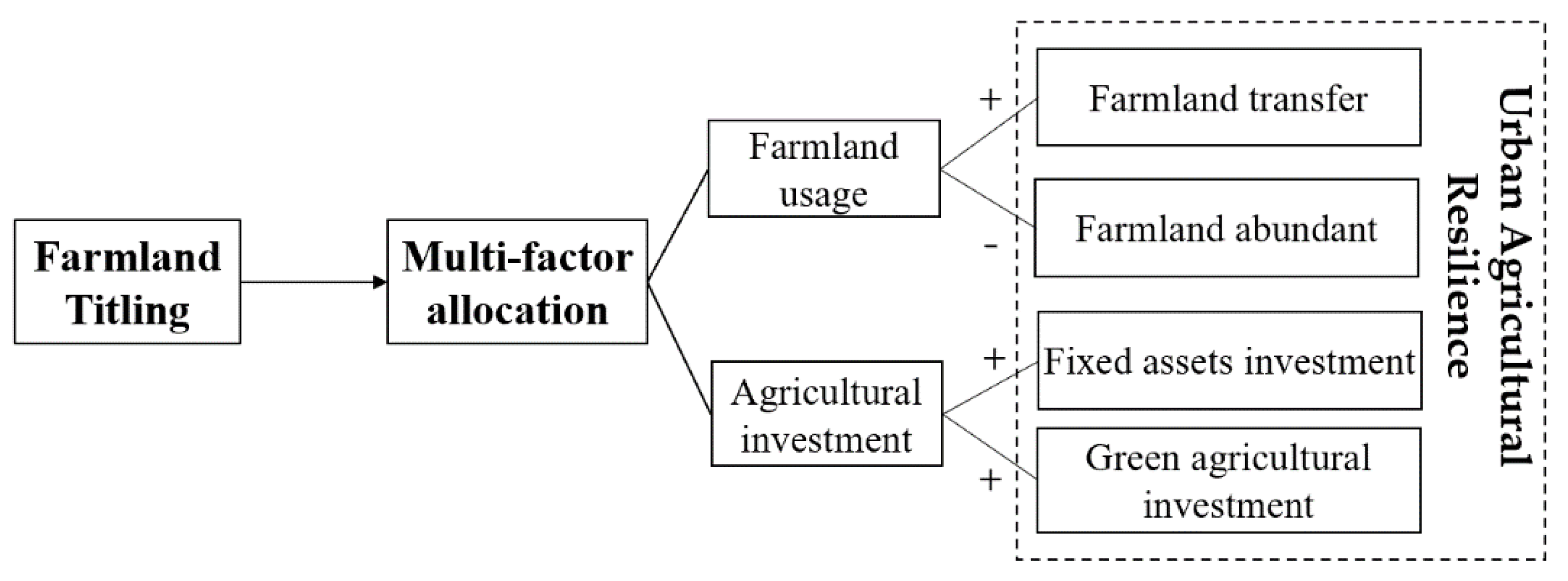
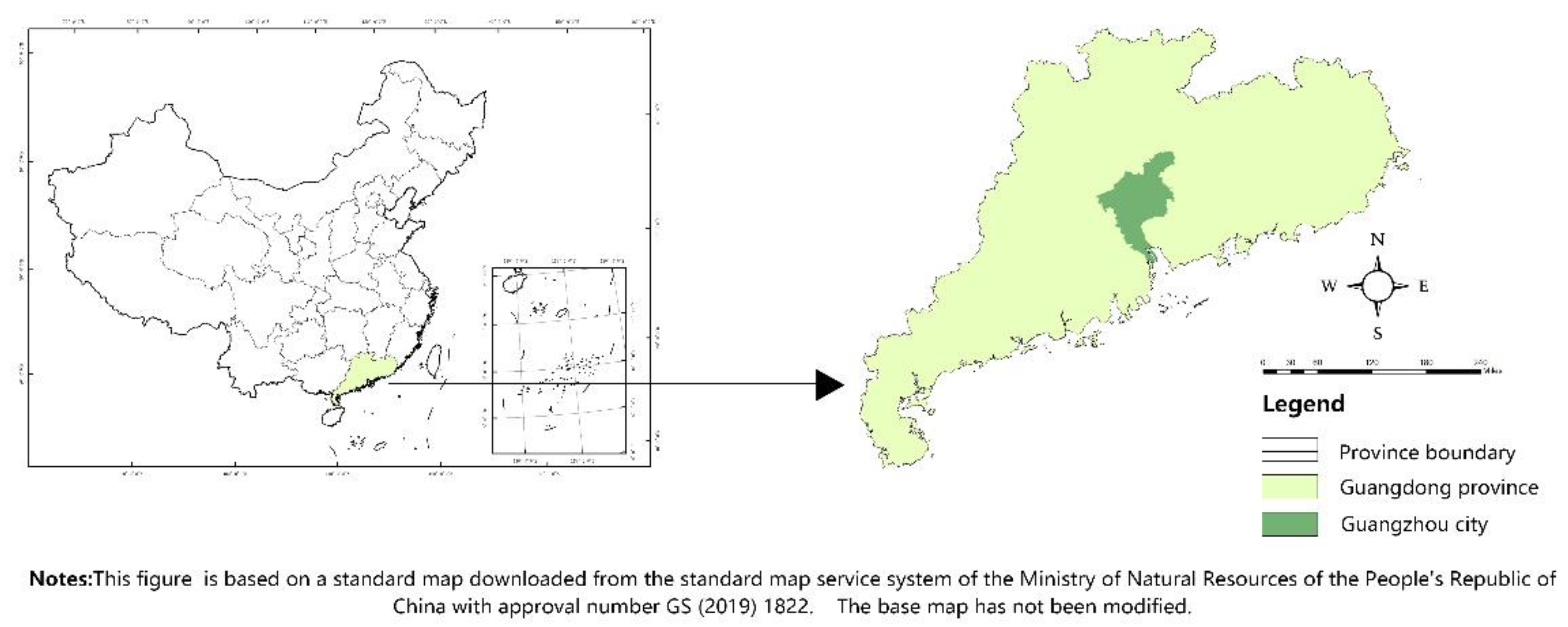
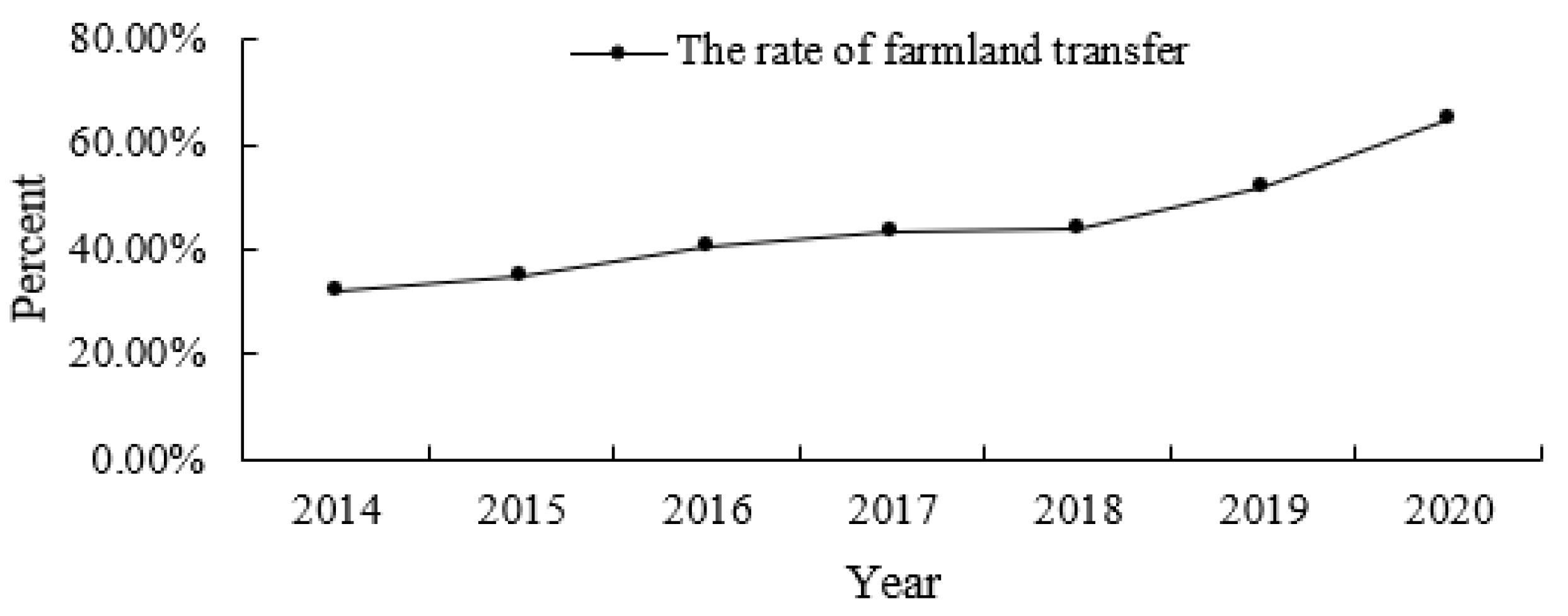
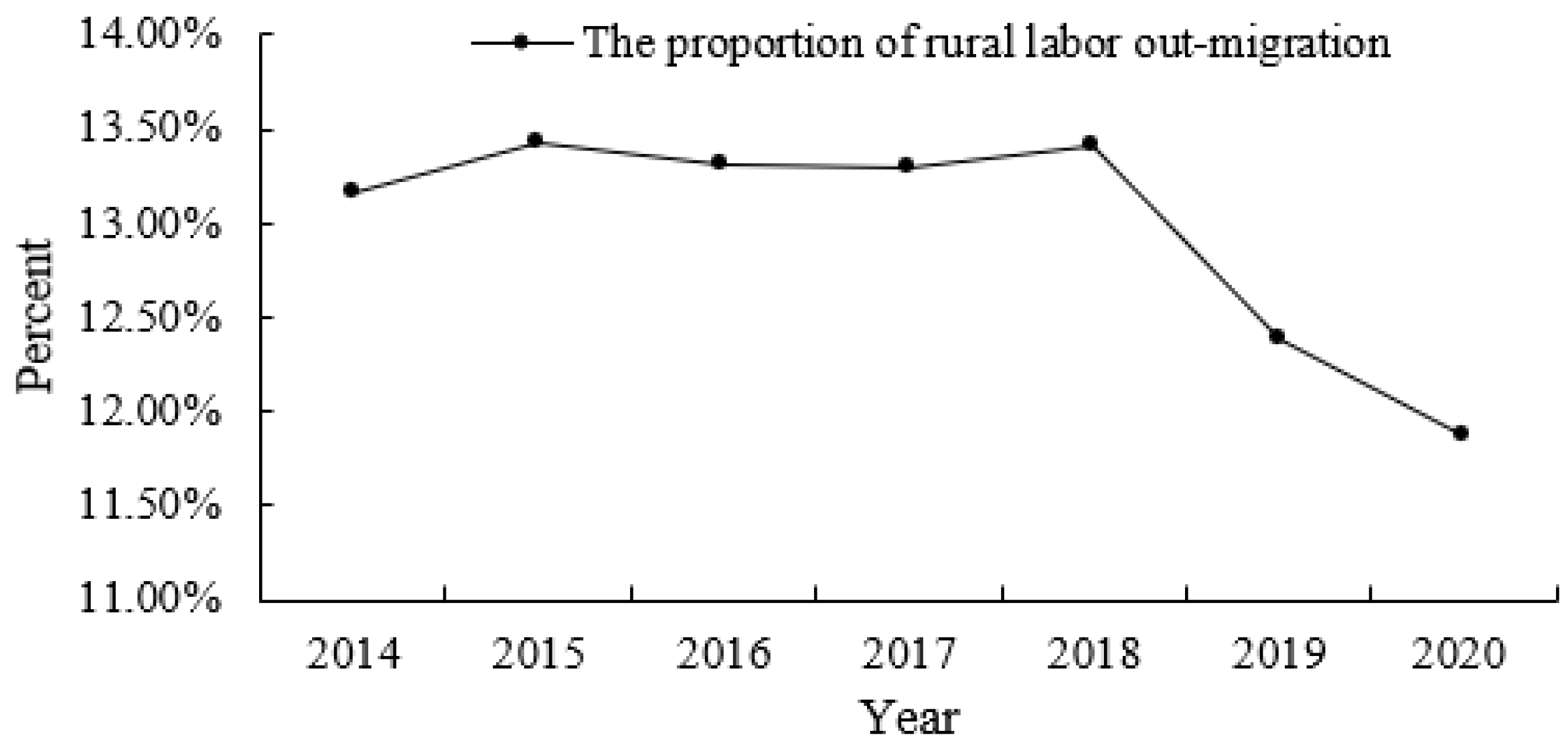
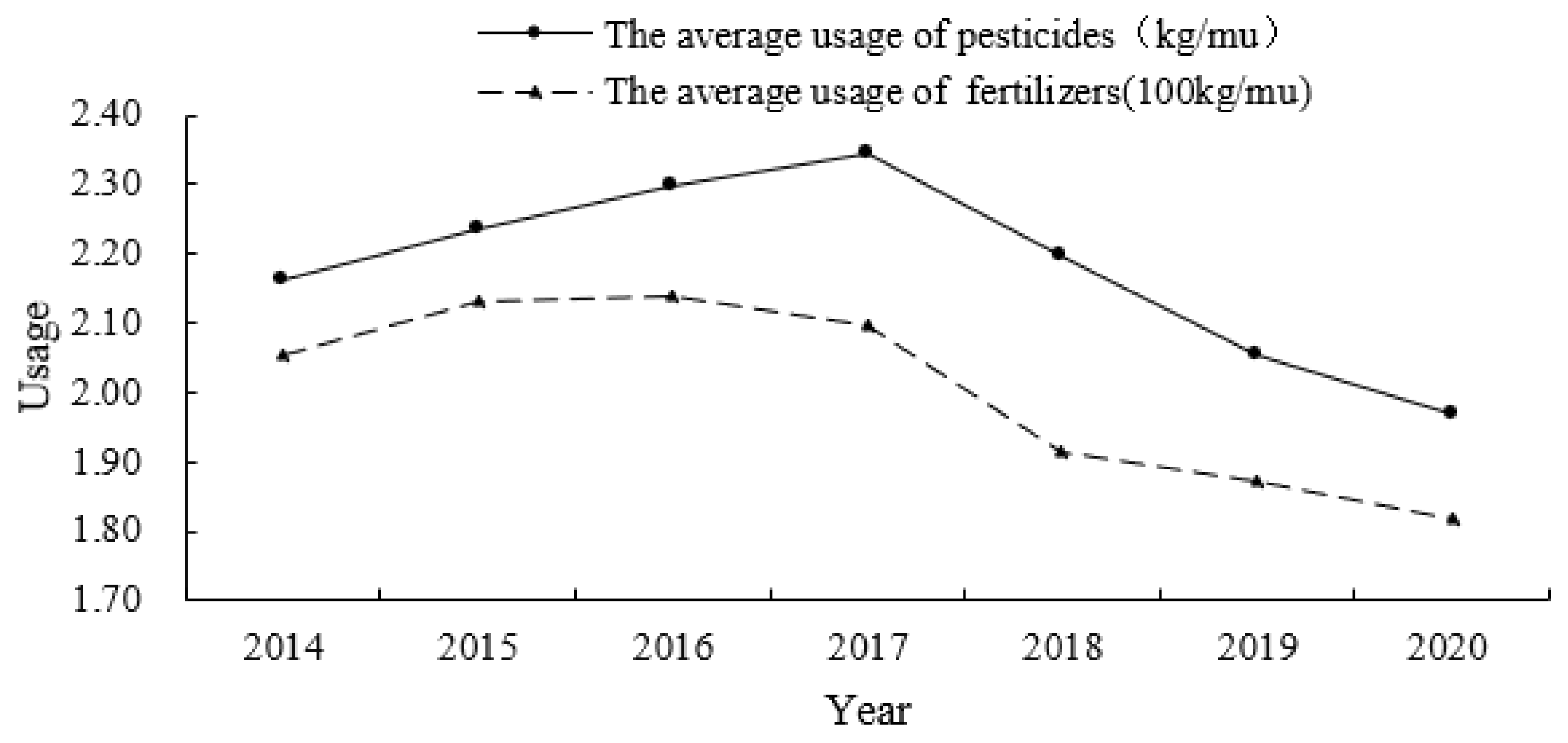
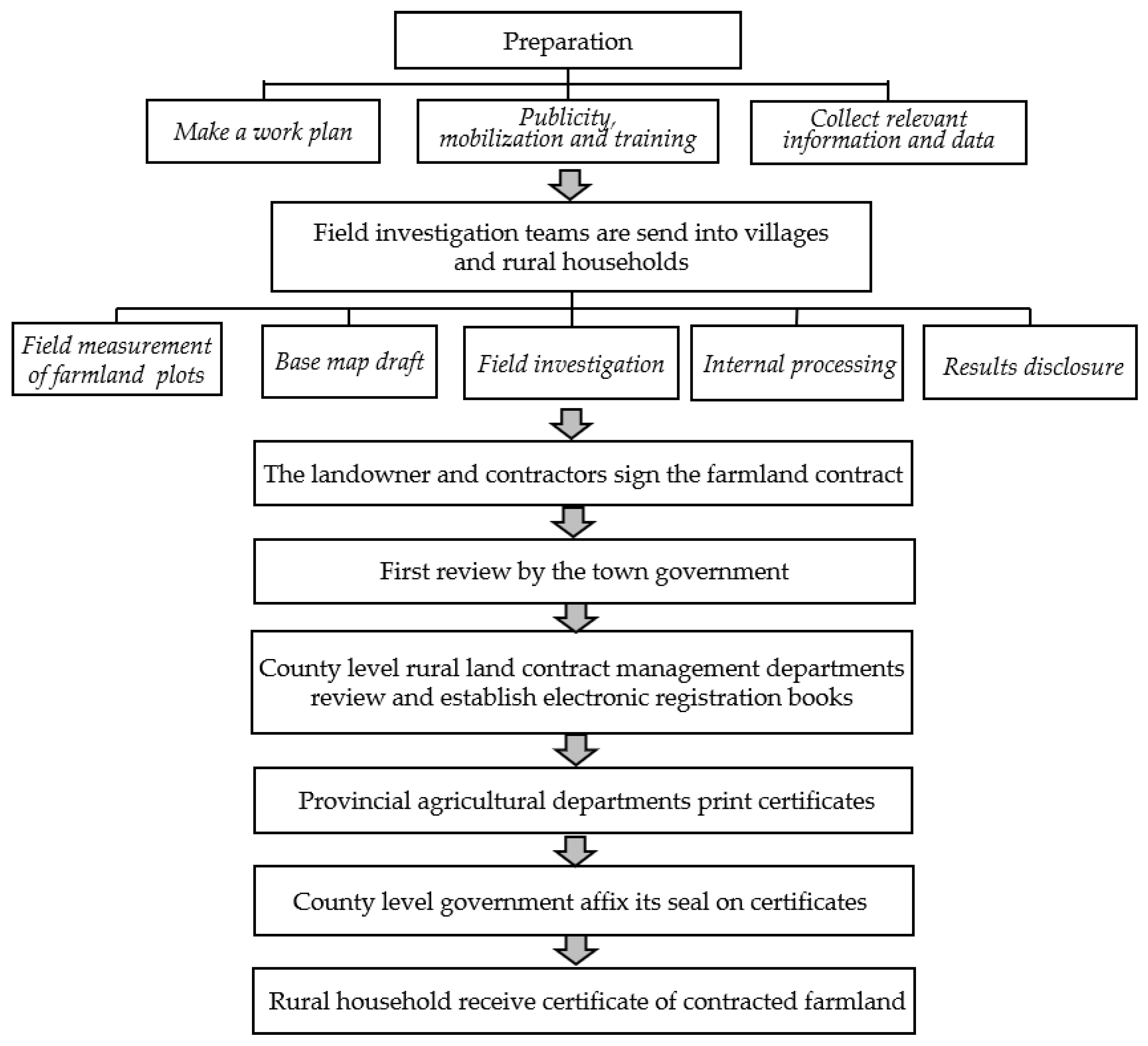
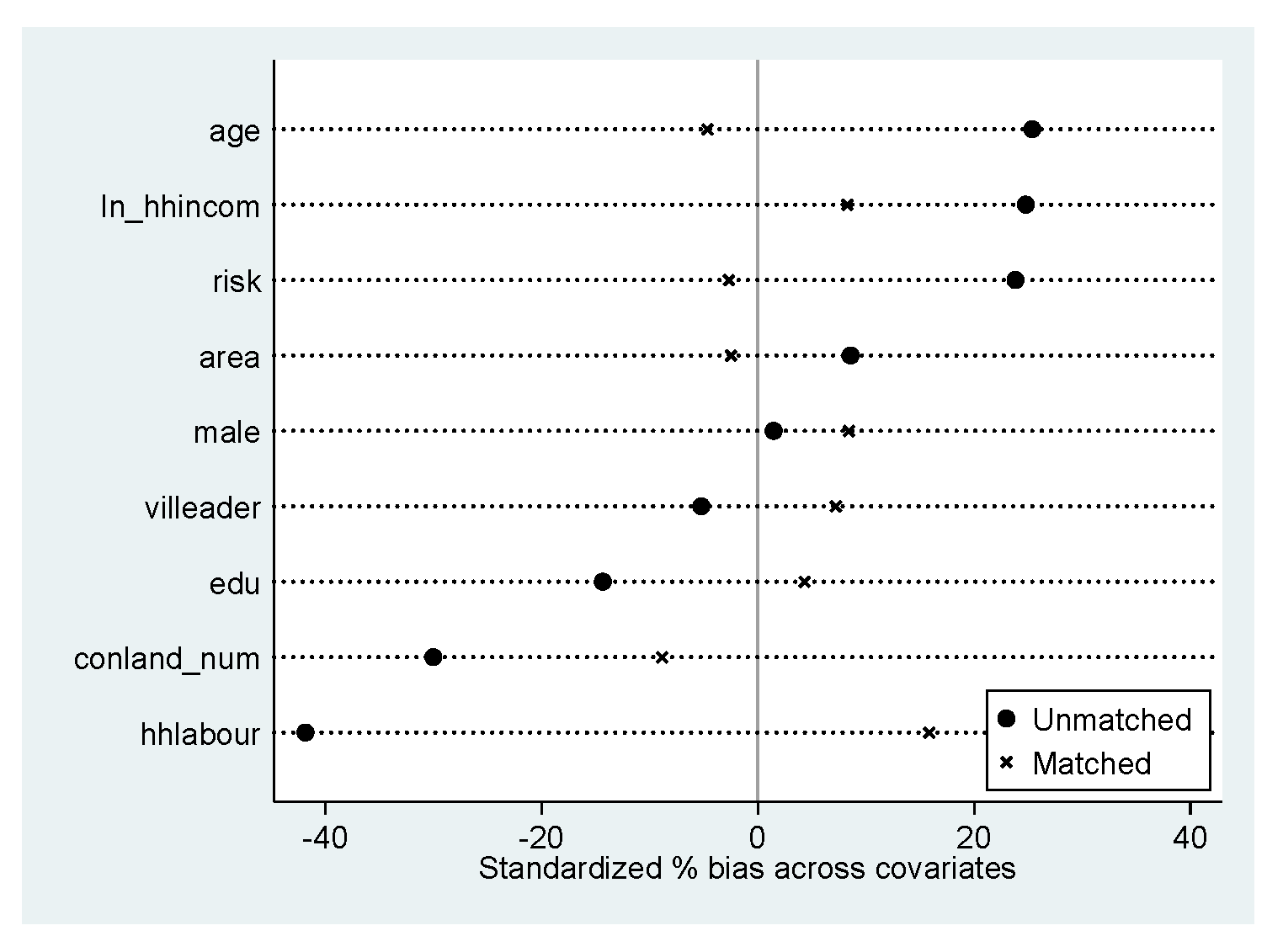
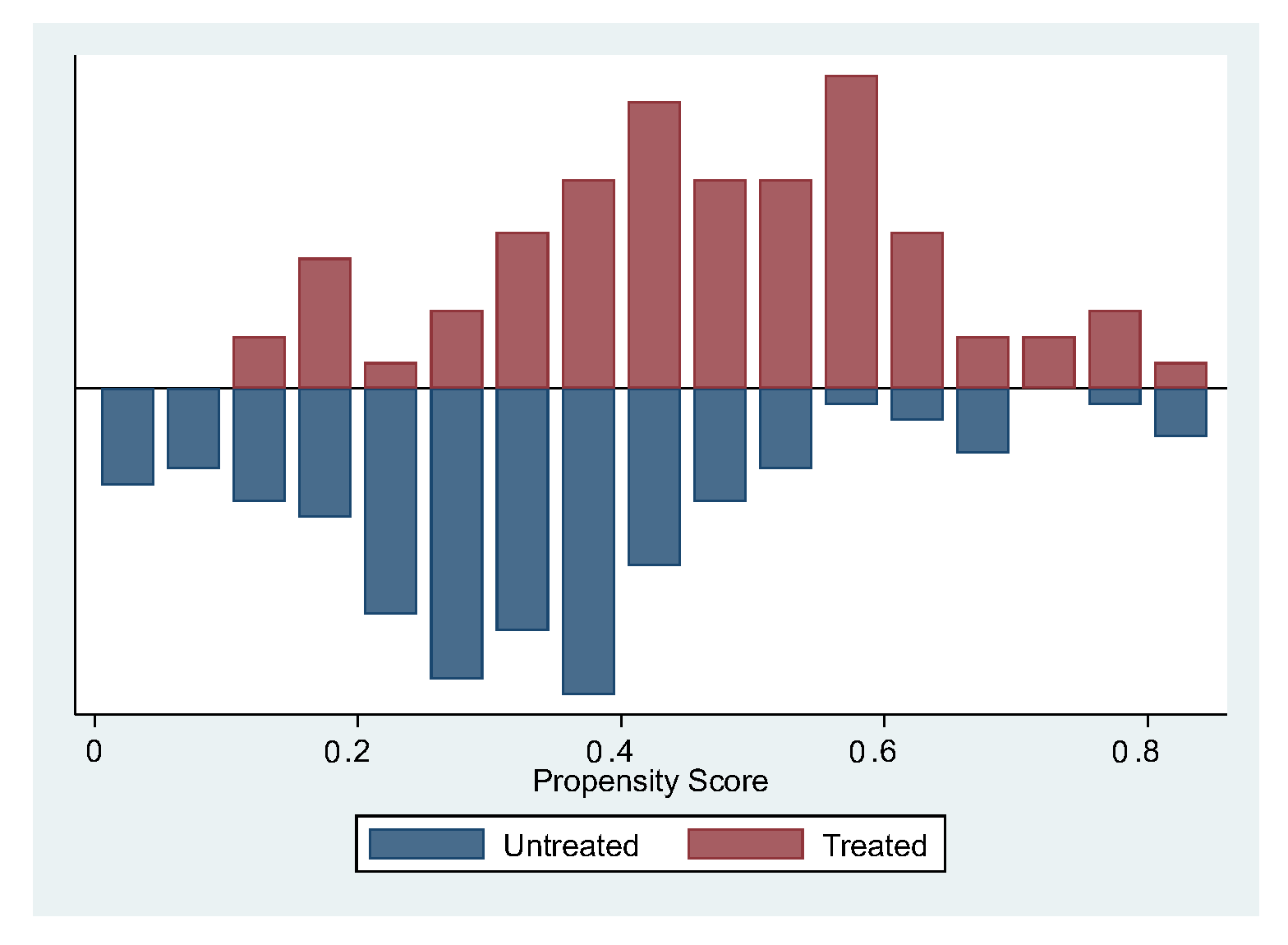
| Variable. | Definitions. | Mean. | S.d. | Min. | Max. |
|---|---|---|---|---|---|
| Farmland titling | Whether a certificate of farmland titling has received (1 = Yes; 0 = No). | 0.382 | 0.487 | 0 | 1 |
| Willingness of transfer-in farmland | Willingness to transfer-in of farmland next year (1 = no; 2 = uncertain; 3 = Yes). | 1.588 | 0.714 | 1 | 3 |
| Willingness of transfer-out farmland | Willingness to transfer-out of farmland next year (1 = no; 2 = uncertain; 3 = Yes). | 1.461 | 0.690 | 1 | 3 |
| Willingness of abandon farmland | Willingness to abandon farmland next year (1= absolutely disagree; 2 = disagree; 3 = neutral; 4 = agree; 5 = absolutely agree). | 1.794 | 0.908 | 1 | 5 |
| Willingness of agricultural investment | Willingness to increase investment in fixed agricultural assets next year (1 = absolutely disagree; 2 = disagree; 3 = neutral; 4 = agree; 5 = absolutely agree). | 3.456 | 0.974 | 1 | 5 |
| Willingness of green agriculture | Willingness to use organic fertilizer next year (1 = absolutely disagree; 2 = disagree; 3 = neutral; 4 = agree; 5 = absolutely agree). | 3.971 | 1.012 | 1 | 5 |
| Age | Age of householder (years). | 51.441 | 12.537 | 21 | 84 |
| Gender | Gender of householder (1 = Male; 0 = Female). | 0.701 | 0.459 | 0 | 1 |
| Education | Education level of householder (years). | 7.765 | 3.288 | 0 | 16 |
| Village cadre | Whether the householder is a village cadre (1 = Yes; 0 = No). | 0.113 | 0.317 | 0 | 1 |
| Risk preference | Lottery experiment of householder (score of 1–5 represents risk preference). | 2.103 | 1.205 | 1 | 5 |
| Farmland Area | Contracted farmland area (mu). | 5.950 | 9.785 | 0.03 | 55 |
| Farmland Plots | Number of contracted parcels (plots). | 4.755 | 3.175 | 1 | 25 |
| Labor force | Number of household labor force members (people). | 3.358 | 1.694 | 0 | 9 |
| Family income | Ln (Total household income (CNY)). | 11.175 | 1.240 | 2.565 | 15.614 |
| Village income | Ln (Village per capita income (CNY)). | 9.309 | 0.524 | 8.412 | 10.177 |
| Village traffic | Time to town center by traffic (hours). | 0.382 | 0.487 | 0 | 1 |
| Variable. | (1) | (2) | (3) | (4) | (5) |
|---|---|---|---|---|---|
| Farmland Transfer-In | Farmland Transfer-Out | Farmland Abandonment | Agricultural Investment | Green Agriculture | |
| Farmland titling | 1.048 *** | –0.265 | –0.660 * | 0.324 | 1.020 *** |
| (0.333) | (0.337) | (0.339) | (0.340) | (0.346) | |
| Age | 0.013 | –0.009 | –0.020 | 0.001 | –0.004 |
| (0.014) | (0.014) | (0.013) | (0.012) | (0.013) | |
| Gender | –0.421 | 0.209 | 0.314 | 0.205 | –0.677 * |
| (0.342) | (0.351) | (0.368) | (0.346) | (0.355) | |
| Education | 0.048 | –0.054 | 0.029 | 0.034 | 0.049 |
| (0.063) | (0.061) | (0.062) | (0.056) | (0.058) | |
| Village cadre | –0.607 | 1.138 ** | 0.989 * | –0.404 | –0.442 |
| (0.465) | (0.518) | (0.587) | (0.471) | (0.506) | |
| Risk preference | 0.055 | –0.020 | –0.276 ** | 0.145 | 0.331 ** |
| (0.127) | (0.129) | (0.123) | (0.135) | (0.142) | |
| Farmland area | –0.022 | –0.008 | –0.062 *** | 0.066 *** | 0.023 |
| (0.022) | (0.022) | (0.023) | (0.023) | (0.021) | |
| Farmland plots | 0.006 | –0.010 | 0.179 ** | 0.001 | –0.004 |
| (0.085) | (0.073) | (0.070) | (0.054) | (0.059) | |
| Labor force | –0.145 | –0.076 | –0.123 | –0.105 | –0.150 |
| (0.106) | (0.103) | (0.108) | (0.096) | (0.096) | |
| Family income | 0.158 | 0.107 | 0.040 | –0.121 | –0.129 |
| (0.158) | (0.152) | (0.153) | (0.119) | (0.117) | |
| Village income | –0.274 | –0.555 | –0.049 | 0.027 | 0.712 ** |
| (0.364) | (0.356) | (0.347) | (0.401) | (0.310) | |
| Village traffic | –2.010 | 0.164 | –3.075 ** | –4.993 *** | 3.148 ** |
| (1.297) | (1.226) | (1.346) | (1.060) | (1.319) | |
| Wald chi2(12) | 24.69 | 10.27 | 36.40 | 44.95 | 48.61 |
| Pseudo R2 | 0.070 | 0.032 | 0.075 | 0.086 | 0.108 |
| Observations | 204 | 204 | 204 | 204 | 204 |
| Items | (1) | (2) | Items | (3) | (4) | (5) |
|---|---|---|---|---|---|---|
| Farmland Transfer-In | Farmland Transfer-Out | Farmland Abandonment | Agricultural Investment | Green Agriculture | ||
| 1 | –0.230 *** | 0.057 | 1 | 0.141 ** | –0.009 | –0.018 ** |
| (0.066) | (0.072) | (0.070) | (0.010) | (0.008) | ||
| 2 | 0.116 *** | –0.031 | 2 | –0.040 * | –0.038 | –0.056 ** |
| (0.033) | (0.039) | (0.022) | (0.041) | (0.024) | ||
| 3 | 0.114 *** | –0.026 | 3 | –0.077 * | –0.021 | –0.090 *** |
| (0.039) | (0.034) | (0.040) | (0.022) | (0.031) | ||
| 4 | –0.018 | 0.047 | –0.027 * | |||
| (0.011) | (0.049) | (0.014) | ||||
| 5 | –0.006 | 0.022 | 0.192 *** | |||
| (0.004) | (0.023) | (0.059) |
| Variable | Willingness | ||||
|---|---|---|---|---|---|
| (3) | (4) | (5) | (6) | (7) | |
| Farmland Transfer-In | Farmland Transfer-Out | Farmland Abandonment | Agricultural Investment | Green Agriculture | |
| Farmland titling | 0.381 *** | –0.112 | –0.176 | 0.081 | 0.345 ** |
| (0.115) | (0.106) | (0.145) | (0.150) | (0.158) | |
| Control variable | YES | YES | YES | YES | YES |
| Constant | 1.525 | 2.904 *** | 2.520 * | 3.996 *** | 1.082 |
| (0.944) | (1.024) | (1.423) | (1.533) | (1.379) | |
| Observations | 204 | 204 | 204 | 204 | 204 |
| R2 | 0.139 | 0.064 | 0.127 | 0.181 | 0.219 |
| Variable | Willingness | ||||
|---|---|---|---|---|---|
| (3) | (4) | (5) | (6) | (7) | |
| Farmland Transfer-In | Farmland Transfer-Out | Farmland Abandonment | Agriculture Investment | Green Agriculture | |
| Farmland titling | 0.246 * | –0.117 | –0.140 | 0.092 | 0.401 ** |
| (0.143) | (0.110) | (0.156) | (0.162) | (0.176) | |
| Control variable | YES | YES | YES | YES | YES |
| Observations | 198 | 198 | 198 | 198 | 198 |
| R2 | 0.137 | 0.080 | 0.137 | 0.242 | 0.187 |
| Variable | Age | Educational Level | |||
|---|---|---|---|---|---|
| Low | High | Low | High | ||
| Willingness | Farmland transfer-in | 1.533 *** (0.566) | 0.845 * (0.447) | 0.882 * (0.500) | 1.103 ** (0.480) |
| Farmland transfer-out | 0.201 (0.481) | –0.912 * (0.526) | –0.135 (0.536) | 0.040 (0.502) | |
| Farmland abandonment | –0.028 (0.510) | –1.013 * (0.538) | –0.907 (0.577) | –0.552 (0.512) | |
| Agricultural investment | 1.098 ** (0.507) | –0.326 (0.464) | –0.178 (0.549) | 0.831 (0.547) | |
| Green agriculture | 0.959 * (0.568) | 0.924 ** (0.458) | 0.130 (0.595) | 1.146 ** (0.477) | |
| Observations | 92 | 112 | 92 | 112 | |
Publisher’s Note: MDPI stays neutral with regard to jurisdictional claims in published maps and institutional affiliations. |
© 2022 by the authors. Licensee MDPI, Basel, Switzerland. This article is an open access article distributed under the terms and conditions of the Creative Commons Attribution (CC BY) license (https://creativecommons.org/licenses/by/4.0/).
Share and Cite
Li, D.; Zhong, W.; Chen, Y. The Role of Farmland Titling in Urban Agricultural Resilience: Evidence from Metropolitan Guangzhou, China. Sustainability 2022, 14, 15781. https://doi.org/10.3390/su142315781
Li D, Zhong W, Chen Y. The Role of Farmland Titling in Urban Agricultural Resilience: Evidence from Metropolitan Guangzhou, China. Sustainability. 2022; 14(23):15781. https://doi.org/10.3390/su142315781
Chicago/Turabian StyleLi, Dan, Wenjing Zhong, and Yitao Chen. 2022. "The Role of Farmland Titling in Urban Agricultural Resilience: Evidence from Metropolitan Guangzhou, China" Sustainability 14, no. 23: 15781. https://doi.org/10.3390/su142315781
APA StyleLi, D., Zhong, W., & Chen, Y. (2022). The Role of Farmland Titling in Urban Agricultural Resilience: Evidence from Metropolitan Guangzhou, China. Sustainability, 14(23), 15781. https://doi.org/10.3390/su142315781




